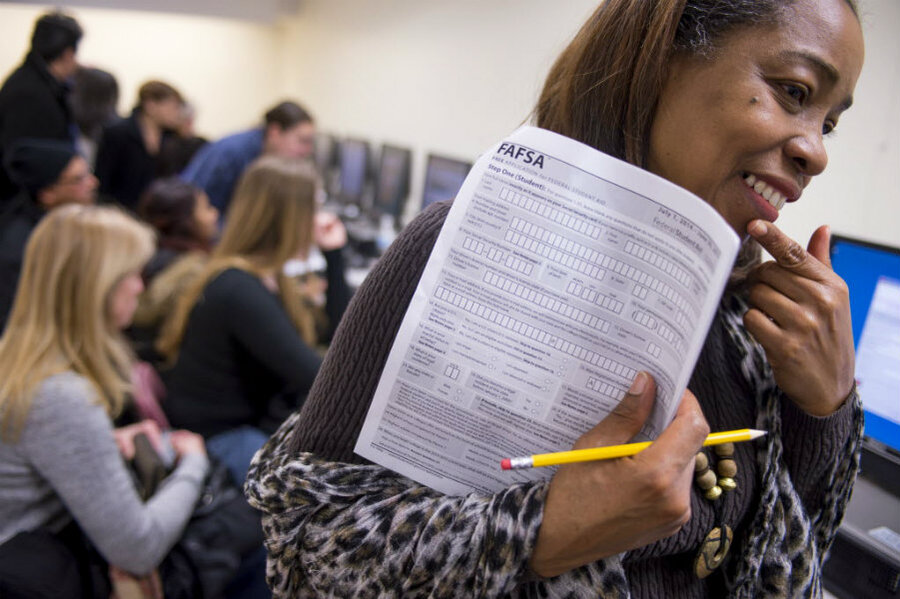How applying for financial aid just got easier for college students
Loading...
In an effort to make college more accessible to low-income families, the Obama administration is launching a new initiative to streamline the process of applying for federal student aid.
Starting next fall, aspiring college students will be able to access the Free Application for Federal Student Aid (FAFSA) form in October rather than January. They also can electronically retrieve and use the prior year's tax information, instead of waiting until the current year’s tax returns have been filed and processed. Under the current system, students find themselves with college acceptance letters that they don't yet know if they can pay for.
The changes will not only reduce “paperwork burdens for students and costs for colleges,” but they will also allow students to apply for aid “when or even before they apply to college,” Lauren Asher, president of The Institute for College Access and Success (TICAS), told The Washington Post.
The changes, part of a week-long effort by the administration to highlight higher education reform, are intended to work alongside the revamped College Scorecard website to provide families and students with better and more complete information about the costs and benefits of a college education. The tweaked FAFSA process would help get financial aid to more low-income students, Education Secretary Arne Duncan told reporters Monday.
“Getting the form filled out earlier will make a real difference for students who think they can’t afford college,” said Secretary Duncan, who with President Obama announced the new regulations Monday at a town hall meeting in Des Moines, Iowa. “We believe literally hundreds of thousands of additional students will actually gain access to critical student aid each year.”
Some high-caliber students don't apply to elite colleges because they assume they can't afford the price tag, he added. "Many elite colleges have larger endowments and can offer more financial aid," he said. "We think some of that under-matching will go away."
As of 2013, tuition at the most expensive private four-year colleges cost close to $50,000 a year – not including room and board, according to a Christian Science Monitor report. At the same time, tuition and fees at four-year public institutions rose by 5.2 percent annually between 2002 and 2013, according to a report by The Institute for College Access and Success.
The result is that for millions of students, receiving financial aid is a crucial condition for going to college. The federal government and colleges use the FAFSA form to determine eligibility for aid, and students who submit their forms earlier have a better chance of qualifying because some schools and nine states award aid on a first-come, first-serve basis until funds run out.
But the process can be problematic. While students wait for their parents’ tax returns, they must delay completing the form – at the expense of grants they may have qualified for. The form also consists of more than 100 detailed questions, making it “an enormous barrier,” especially for low-income families and first-generation college students, says Mandy Savitz-Romer, faculty director of the Prevention Science and Practice program at the Harvard Graduate School of Education.
“It’s an onerous form… [and] families who have not been to college themselves have a more difficult time completing it,” she says.
About 2 million students who would have qualified for a federal Pell Grant in 2011 to 2012 did not file the FAFSA, many of them saying they assumed they were ineligible, lacked information about how to apply, or thought the forms were too much work, according to a recent analysis by student financial aid expert Mark Kantrowitz, senior vice president and publisher of Edvisors.com.
With the online form, IRS retrieval will prefill questions for applicants, and skip logic helps them bypass other questions that don't apply to their situations.
“The prior-year tax information is going to be extremely helpful,” says Jillian Kelton, director of student services at TechBoston Academy, a pilot school for grades 6 to 12 in Dorchester, Mass.
Making the form available three months earlier also gives students more time to consult with school counselors and staff, Professor Savitz-Romer notes.
As with any policy change, challenges exist.
“Any new tool is only as effective as the people on the ground who are using it,” Savitz-Romer says.
That means schools need to explain to staff what the changes mean for their students. Such efforts require “thinking differently so that [the policy] can have the profound impact it’s designed to have,” she says.
Still, she says, it’s “a tremendous step forward.”
Duncan did not provide a figure for how much the FAFSA changes will cost, but said the administration expects Pell Grant costs to rise by about 1 percent, or $400 million, once the changes go into effect and more students apply, according to The Washington Post.








